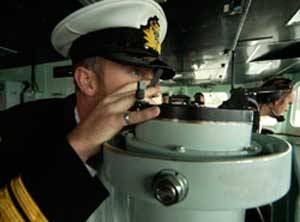Navy Seaman Officer
Tasks & duties

When posted at sea, navy seaman officers may do some or all of the following:
-
act as the commanding officer’s representative on the bridge of the ship
-
plan and direct passage plans, which involves planning route, duration and sailing speed
-
monitor the progress of the passage plan
-
ensure safe navigation of the ship and the safety of the ship’s boats and crew
-
ensure the safety and security of the ship when in port
-
ensure that the ship's daily routine is followed
-
ensure the ship is well maintained and prepared for battle
-
initiate action in the event of emergencies
-
participate in wartime-scenario training exercises, such as damage-control exercises
-
manoeuvre the ship during warfare exercises and helicopter operations
-
practise machinery breakdown exercises
-
give launch and landing permission to the helicopters
-
supervise other ranks carrying out tasks such as anchoring, fuelling, towing, launching and recovery of the ship's boats, and transfer of personnel at sea
-
lead boarding parties onto other boats to check them
-
manage the careers of lower ranks
When posted onshore, navy seaman officers may do some or all of the following:
-
policy work
-
technical administration
-
manage projects for the procurement and installation of new systems or equipment
-
plan and undertake training duties
-
co-ordinate international training exercises with other countries' navies
-
plan navy deployments or tri-service agreements (work involving the Army, the Air Force and the Navy)
Specialisations
Diving Officer
Diving officers manage and participate in operations such as underwater ship maintenance, and salvage and demolition work. Diving officers are part of the Maritime Mine Warfare Force, which works to reduce the number of mines and bombs on the seabed.They also assist in looking for missing people, and help the Customs Service, the New Zealand Police and other government agencies with diving-related tasks.
Airborne Tactical Officer (TACCO)
Airborne tactical officers manage helicopter missions. They navigate during the flight and co-ordinate and operate the systems and weapons on the aircraft.
Principal Warfare Officer (PWO)
Principal warfare officers are in charge of the fight capability of navy ships.
Skills & knowledge
Navy seaman officers need to have:
-
knowledge of maritime regulations and safety procedures
-
knowledge of meteorology and the ability to interpret ocean and weather conditions
-
navigational skills
-
skill in analysing and interpreting information
-
technical and planning skills
-
knowledge of Royal NZ Navy regulations and safety procedures
-
leadership skills and decision-making ability
-
good communication skills
-
knowledge of how to operate various weapons systems and sensors
Navy seaman officers also need general knowledge of warfare tactics, which is developed if they choose to specialise as a principal warfare officer.
Entry requirements
To enter the Royal NZ Navy you must be at least 17 years old and eligible to be a New Zealand citizen. You need to pass a series of psychometric tests and an interview. You must then pass medical and fitness tests and meet an acceptable standard of eyesight and hearing. You also need to be given security clearance, so any criminal convictions you have will be looked at.
To become a navy seaman officer you need to have NCEA Level 3, including 80 credits over five subjects. You must have a minimum of 14 credits at Level 1 or above in maths, and a minimum of 14 credits at Level 2 or above in English, or School Certificate equivalent.
Navy seaman officers may enter through the Navy midshipman scheme (university) under which you are sponsored to complete a full-time degree, the Navy midshipman scheme (non-university) under which you complete most training on the job and are sponsored to take some university papers, or as a graduate.
Tertiary Education
Navy seaman officers generally complete a Bachelor of Arts, a Bachelor of Science, or management studies.
The Royal NZ Navy sponsors suitable candidates through university or reimburses relevant study already completed. There are various sponsorship schemes available.
If you are being sponsored to study full-time, you will be posted to a ship or shore establishment for on the job training during study breaks.
Training on the job
On-the-job training begins with a six-month Junior Officer Common Training Course (JOCT) at the Royal NZ Naval College. This course serves as a general introduction to the Royal NZ Navy and prepares you for general duties as a naval officer.
You then complete the Grade III Officer of the Watch (OOW) course where you learn the basics of coastal navigation, communications and bridge management. You are then posted to a ship to practise what you have learned.
After this, navy seaman officers on the midshipman scheme (university) begin full-time study for three years and those on the non-university scheme continue on-the-job training to achieve more advanced certification. Those on the university scheme work towards the same certificates after achieving their university degree. The NZ Maritime Safety Authority endorses these certificates.
Navy seaman officers also complete the officer's leadership development programme, which is taught in conjunction with the Auckland Polytechnic.
Useful experience
A regular fitness programme, involvement in youth organisations, or team activities is useful experience. Sailing experience is also useful.
Related courses
Marine Craft Operation
For more information, please refer to Career Services.
Document Actions
